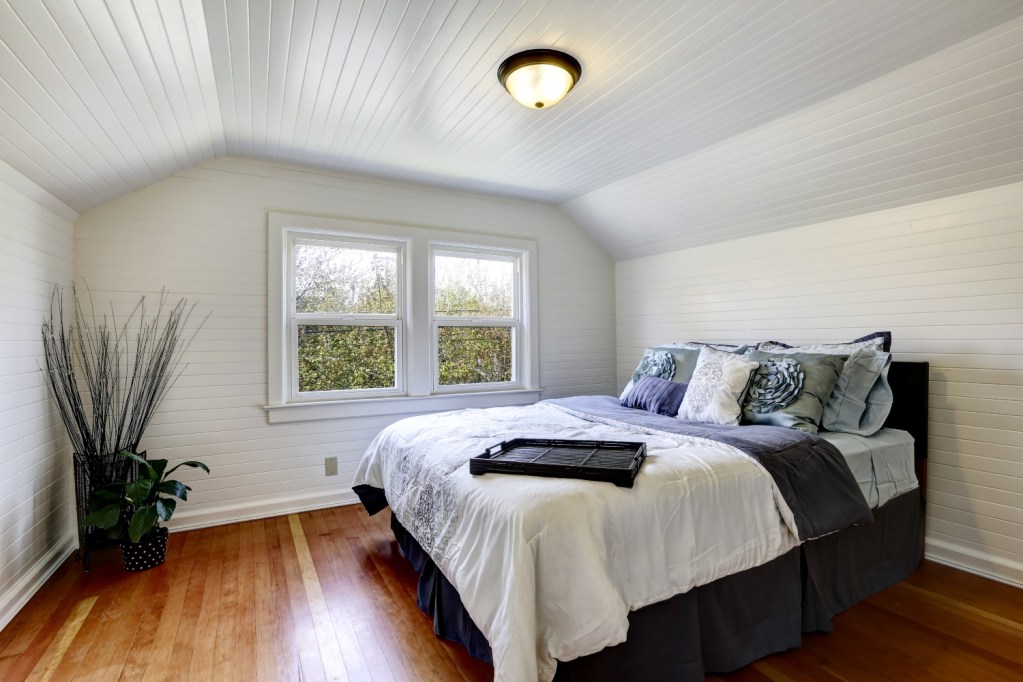Beadboard ceilings add a cozy, charming look to any space. Particularly popular in coastal or Cape Cod interiors, these ceilings generate more visual appeal and pay homage to an old design tradition. But what exactly is beadboard? Is it right for your home? We weigh the pros and cons with everything you need to know about beadboard ceilings.
What is beadboard?

Beadboard is a type of wood paneling that can be installed on the wall in place of wainscoting or on the ceiling for a charming look. Beadboard gets its name from its visual appearance of several rows of vertical planks separated by grooves known as “beads.” This paneling is installed with the tongue-in-groove method, where each plank has an indentation or a protrusion that can interlock for a sturdier final product.
Beadboards are typically sold in sheets of 4 feet by 8 feet, with smaller, narrow boards spaced every 2 inches to give the appearance of several smaller planks lined side by side. Other sizing options are also available, depending on your home improvement store.
Pine is the most common material for beadboard, often 5/16 inches to 3 1/2 inches thick. MDF or plywood boards are also an option, typically 3/16 inches thick. One thing to consider before buying beadboard is the amount of humidity and heat fluctuation in your home. Traditional wood beadboards may shrink or expand in heat, so MDF beadboard might be a better option in some interiors.
History of beadboard in the home
Beadboard originated in England nearly four centuries ago as a practical means of insulation from heat and moisture. By the 1800s, it was brought to New England and used in many homes as a type of wainscoting to provide insulation and protect walls from scuffs created by chair backs. This is why you can see beadboards in colonial and Cape Cod interiors on the New England coast.
By the 1920s, beadboard had waned out of fashion in place of fancy wallpaper that had become vogue. Today, many homeowners and interior designers still adore the cozy look of beadboard, both on the walls and ceilings. Many Eastern U.S. coastal homes will boast an elegant beadboard ceiling or wall covering in honor of the style’s history and tradition in the area.
How to install beadboard

Installing beadboard can be done by hand. However, many homeowners may struggle to install it correctly on the ceiling, as this can present more challenges than adding beadboard as wainscoting.
Beadboards cost, on average, $1.50 per square foot for the individual sheets. You can DIY your beadboard ceiling by adhering the sheets with adhesive and following up with brad nails. Just be sure that the beadboards are level and straight.
We recommend hiring a professional for installation. Keeping your beadboards level and straight can be tricky for some homeowners. While professional installation could cost an extra $2 to $4 per square foot, you can rest assured that the job will be done right.
Pros and cons of a beadboard ceiling

Here are the pros and cons of installing a beadboard ceiling.
Pros
- Beadboard ceilings add more visual appeal to your home. They’re charming and cozy, perfect for farmhouse or Cape Cod interior designs. The sleek look of beadboard ceilings can also benefit some coastal designs.
- Beadboard can hide ceilings that look out of date. For example, many homeowners dislike the look of popcorn ceilings, which can appear tacky in modern designs. However, removing popcorn ceilings is no small or inexpensive feat. To save time and money, covering an ugly ceiling with beadboard can be a great choice to spruce up the look of your space.
- Beadboard is relatively affordable.
- You can customize the color of your beadboard to suit your space.
- Homeowners can DIY their beadboard ceiling if they choose.
Cons
- DIYing beadboard ceiling installation is a challenging task. While it is possible to DIY your beadboard ceiling installation, it could be better left up to a professional. Hiring a professional will increase installation costs, however. Though, you can rest assured that your beadboard ceiling will look stunning.
- Water damage or mold on your ceilings is something to consider before adding beadboard. If you know you have water damage or leaky pipes in your home, you’ll want to tackle that first, before adding beadboard to your ceiling. Additionally, beadboard can hide water damage for a while before you discover it. So, if you own an older home, it’s a good idea to thoroughly inspect your space and update the plumbing (if necessary) before adding beadboard ceilings.
- Don’t add beadboard unless you’re certain it’s the look you’re going for. Beadboard is a prominent design feature. It makes a statement in your space. If you add it to your ceilings, be sure it’s the look you want. Tearing out beadboard is a time-consuming and costly task, leaving you with plenty of nail holes and dried glue you’ll have to repair. So, ensure that a beadboard ceiling is the look you want before investing.
Beadboard ceilings look gorgeous in coastal, Cape Cod, and farmhouse interiors. If you want to spruce up your space with more visual appeal or add a vintage touch, beadboard can be a great choice.




